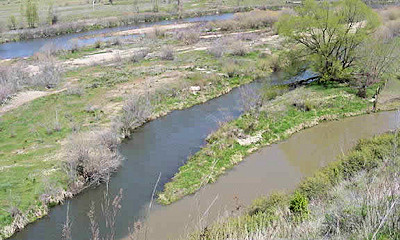May 25, 2016

This week the Bureau of Reclamation announced it will provide funding to five projects to promote watershed health and wildfire resiliency, protect municipal and agricultural water supplies and improve infrastructure. The $482,967 in funding is part of the Western Watershed Enhancement Program across five states - Arizona, California, Colorado, Idaho and Washington.

CLEAN IT UP: This image from the Boise River shows how sediment can cause trouble (see bottom half of the photo). It's just one challenge the Bureau of Reclamation is tackling. (Photo: Lower Boise River Watershed)
Estevan Lopez, BR commissioner, notes that "Reclamation is collaborating with others to ensure a sustainable water supply for our future generations. Through the Western Watershed Enhancement Program, more landscapes in western watersheds and forests will remain healthy and resilient to risks associated with drought and climate changes, such as wildfires."
The agency says the projects will help improve watershed health, cut wildfire risk and post-wildfire sedimentation through the rehabilitation of fire-damaged areas. Here's an overview of the five projects starting with the three in the Western Farmer-Stockman coverage area:
Glacier Creek to Mill Creek Fuel Reduction Project (Colorado): Reclamation is providing $84,500 toward the reduction of fuel loads to help prevent wildfires from spreading and improve watershed health by focusing on enhancing existing fire barriers such as roads, trails and rivers on 210 acres in Rocky Mountain National Park in the headwaters of the Colorado-Big Thompson Project. This is part of the Colorado-Big Thompson Headwaters Partnership, a collaborative effort among the Bureau of Reclamation, U.S. Forest Service, the State of Colorado, Rocky Mountain National Park, Western Area Power Administration and Northern Water Conservancy District.
Boise River Pilot Project (Idaho): Reclamation is providing $70,000 toward two distinct projects in the Boise River watershed to minimize post-fire erosion and sediment loads, stabilize soils and establish more fire-resilient forests and habitats. Funding will go toward planting 17,000 seedlings, which amount to about 200 trees per acre over 85 acres; removing non-native invasive species on 200 to 400 acres of land, which are flourishing in post-fire conditions; and restoring native, fire-resistant vegetation. These are two components of a broader watershed improvement partnership between the Bureau of Reclamation and the U.S. Forest Service in the Boise River Basin.
Yakima Watershed Enhancement Project (Washington): Reclamation is providing $150,644 toward this project to reduce wildfire risk on 730 acres of land within the catchment basin that flows into Rimrock Reservoir in Washington state. These treatments help reduce the potential for large-scale wildfires and associated post-fire impacts such as entry of sediment, debris and contamination into water supplies and facilities. Additional support for this project is also being provided by the U.S. Forest Service, The Nature Conservancy, Washington Department of Natural Resources and the Yakima Nation.
Cragin Watershed Protection Project (Arizona): Reclamation is providing $76,739 toward this project to remove hazardous fuels from overstocked forest stands, which will reduce fire threats. It includes mechanical and hand treatments on 39,000 acres and prescribed fires on 64,000 acres to reduce risks within and adjacent to the three sub-watersheds that drain into Cragin Reservoir. The project will also advance field work to address environmental impacts. This project is a collaborative effort among the Bureau of Reclamation, U.S. Forest Service, Salt River Project and National Forest Foundation.
Hemlock Project (California): Reclamation is providing $96,084 toward this project to support a 12,000-acre watershed enhancement study on the Stanislaus National Forest at the headwaters of the Mokelumne River. The Project partners Reclamation with the Forest Service and the University of California and is part of the larger Sierra Watershed Ecosystem Enhancement Project (SWEEP). Its goal is to produce a quantitative assessment of the impacts of watershed enhancement approaches that is scalable across the Sierra Nevada and potentially other forests.
The Western Watershed Enhancement Partnership was formally established in July 2013, by Secretary of the Interior Sally Jewell and Secretary of Agriculture Tom Vilsack. It is a part of President Obama's Climate Action Plan, outlining a comprehensive approach to prepare the United States for the impacts of climate change, including increased risk of wildfires and drought.
You can learn more about the agency and its programs at usbr.gov.
You May Also Like




